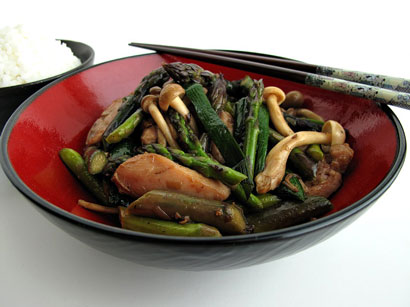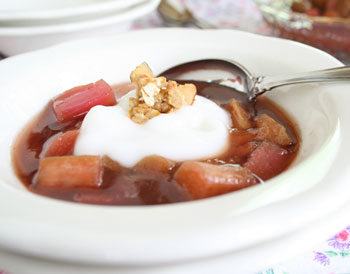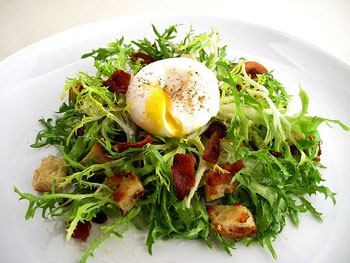 I've always been a big Globe artichoke kind of girl. That was until a couple of years ago when I tried baby artichokes. Now, I have learned to divide my love between them both.
I've always been a big Globe artichoke kind of girl. That was until a couple of years ago when I tried baby artichokes. Now, I have learned to divide my love between them both.
Baby artichokes are fully mature artichokes, as their rich, earthy flavor attests to, but they're picked from the lower part of the plant, where they simply don't develop as much. As a result, the artichoke's characteristic fuzzy choke isn't all that fuzzy and can be eaten.
In fact, other than a few tough outer loves, the entire artichoke is edible. So baby artichokes have all the flavor of their larger counterparts but without all the work. That's why they're ideal for a mid-week meal.
Select baby artichokes that are heavy for their size and have tight, firm, green or purple tinged leaves. White or brown streaks indicate frost bite or wind-burn; they are still edible, just unattractive. Do not, however, buy them if they're spongy or appear overly dry, brittle, or pitted. Baby artichokes can be refrigerated for up to 4-5 days, though the sooner you use them the better they'll taste.

 What do Jerusalem artichokes, horseradish and dandelion greens have in common? You'll never guess. Each has a name that is an English version of a foreign name. The Jerusalem artichoke is a variety of sunflower, and the name is derived from "girasole" which means sunflower in Italian. Horseradish is "meerrettich" in German and because "meer" sounds like "mare" the English called it horseradish. Dandelion comes from the French "dent de lion" or lion's tooth, in reference to the jagged leaves of this bitter yet tasty weed.
What do Jerusalem artichokes, horseradish and dandelion greens have in common? You'll never guess. Each has a name that is an English version of a foreign name. The Jerusalem artichoke is a variety of sunflower, and the name is derived from "girasole" which means sunflower in Italian. Horseradish is "meerrettich" in German and because "meer" sounds like "mare" the English called it horseradish. Dandelion comes from the French "dent de lion" or lion's tooth, in reference to the jagged leaves of this bitter yet tasty weed. If you've been hoping to brush up on your stir-fry skills, there's no better time to do just that than now. Spring gives you the best opportunity with so many different vegetables to cook with—and they're all amazing in a stir-fry. There are green beans, broccoli, asparagus, and soon there will be peas, but in the meantime green garlic is what you should be looking for in the farmers' market.
If you've been hoping to brush up on your stir-fry skills, there's no better time to do just that than now. Spring gives you the best opportunity with so many different vegetables to cook with—and they're all amazing in a stir-fry. There are green beans, broccoli, asparagus, and soon there will be peas, but in the meantime green garlic is what you should be looking for in the farmers' market. Bemidji’s Natural Choice Farmers Market opened for the season yesterday. I was there with my market bag, filling it with fresh butter lettuce, baby turnips, green onions and beautiful rosy red radishes. Oh, and I can’t forget the homemade bread.
Bemidji’s Natural Choice Farmers Market opened for the season yesterday. I was there with my market bag, filling it with fresh butter lettuce, baby turnips, green onions and beautiful rosy red radishes. Oh, and I can’t forget the homemade bread. Salade Lyonnaise is one of the most popular salads in small French restaurants and bistros. In Lyon, from where the salad originates, it is typically found on the menus of tiny eateries called Bouchons, which specialize in comfort foods such as soups, stews, sausages, cheeses, etc. You can most certainly also find this salad served at Thomas Keller's Bouchon and at many of the restaurants of Lyon native Daniel Boulud. Comfort food knows no boundaries of class. It is simply just that popular that both high and low places offer it. And why wouldn't this salad be comforting? It is made of lettuce, croutons, bacon, and a poached egg perched on top.
Salade Lyonnaise is one of the most popular salads in small French restaurants and bistros. In Lyon, from where the salad originates, it is typically found on the menus of tiny eateries called Bouchons, which specialize in comfort foods such as soups, stews, sausages, cheeses, etc. You can most certainly also find this salad served at Thomas Keller's Bouchon and at many of the restaurants of Lyon native Daniel Boulud. Comfort food knows no boundaries of class. It is simply just that popular that both high and low places offer it. And why wouldn't this salad be comforting? It is made of lettuce, croutons, bacon, and a poached egg perched on top.